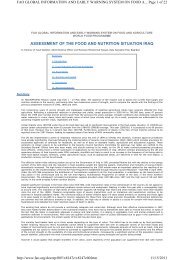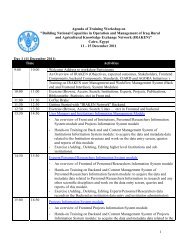Vermiculture in Egypt: - FAO - Regional Office for the Near East and
Vermiculture in Egypt: - FAO - Regional Office for the Near East and
Vermiculture in Egypt: - FAO - Regional Office for the Near East and
You also want an ePaper? Increase the reach of your titles
YUMPU automatically turns print PDFs into web optimized ePapers that Google loves.
2. Trial of vermiculture <strong>and</strong> vermicompost<strong>in</strong>g<br />
implementation <strong>in</strong> <strong>Egypt</strong><br />
The historical background, geographic distribution of earth worms, types of<br />
earthworms, native earthworm species, <strong>for</strong>mal def<strong>in</strong>itions of vermiculture <strong>and</strong><br />
vermicompost<strong>in</strong>g, <strong>and</strong> a comparison between compost <strong>and</strong> vermicompost were<br />
<strong>in</strong>troduced <strong>in</strong> <strong>the</strong> previous chapter. This chapter deals with <strong>the</strong> physical requirements<br />
of vermiculture <strong>and</strong> vermicompost, <strong>and</strong> ends by <strong>the</strong> implementation trial of both<br />
vermiculture <strong>and</strong> vermicompost <strong>in</strong> <strong>Egypt</strong>, <strong>in</strong>clud<strong>in</strong>g all details of this trial.<br />
2.1. Pr<strong>in</strong>ciple of vermiculture <strong>and</strong> vermicompost<strong>in</strong>g<br />
Compost worms need five basic pr<strong>in</strong>ciples: a hospitable liv<strong>in</strong>g environment, usually<br />
called “bedd<strong>in</strong>g”, a food source, adequate moisture (greater than 50% water content<br />
by weight), adequate aeration, <strong>and</strong> protection from temperature extremes. These five<br />
essentials are discussed below <strong>in</strong> more details accord<strong>in</strong>g to Munroe (2007).<br />
2.1.1. Bedd<strong>in</strong>g<br />
Bedd<strong>in</strong>g is any material that provides <strong>the</strong> worms with a relatively stable habitat. This<br />
habitat must have <strong>the</strong> follow<strong>in</strong>g characteristics:<br />
- High absorbency. Worms brea<strong>the</strong> through <strong>the</strong>ir sk<strong>in</strong>s <strong>and</strong> <strong>the</strong>re<strong>for</strong>e must have a<br />
moist environment <strong>in</strong> which to live. If a worm‟s sk<strong>in</strong> dries out, it dies. The bedd<strong>in</strong>g<br />
must be able to absorb <strong>and</strong> reta<strong>in</strong> water fairly well if <strong>the</strong> worms are to thrive.<br />
- Good bulk<strong>in</strong>g potential. If <strong>the</strong> material is too dense to beg<strong>in</strong> with, or packs too<br />
tightly, <strong>the</strong>n <strong>the</strong> flow of air is reduced or elim<strong>in</strong>ated. Worms require oxygen to live,<br />
just as we do. Different materials affect <strong>the</strong> overall porosity of <strong>the</strong> bedd<strong>in</strong>g through<br />
a variety of factors, <strong>in</strong>clud<strong>in</strong>g <strong>the</strong> range of particle size <strong>and</strong> shape, <strong>the</strong> texture, <strong>and</strong><br />
<strong>the</strong> strength <strong>and</strong> rigidity of its structure.<br />
- Low prote<strong>in</strong> <strong>and</strong>/or nitrogen content (high carbon: nitrogen ratio). Although <strong>the</strong><br />
worms do consume <strong>the</strong>ir bedd<strong>in</strong>g as it breaks down, it is very important that this be<br />
a slow process. High prote<strong>in</strong>/nitrogen levels can result <strong>in</strong> rapid degradation <strong>and</strong> its<br />
associated heat<strong>in</strong>g, creat<strong>in</strong>g <strong>in</strong>hospitable, often fatal, conditions. Heat<strong>in</strong>g can occur<br />
safely <strong>in</strong> <strong>the</strong> food layers of <strong>the</strong> vermiculture or vermicompost<strong>in</strong>g system, but not <strong>in</strong><br />
<strong>the</strong> bedd<strong>in</strong>g.<br />
Some materials make good bedd<strong>in</strong>gs all by <strong>the</strong>mselves, while o<strong>the</strong>rs lack one or more<br />
of <strong>the</strong> above characteristics <strong>and</strong> need to be used <strong>in</strong> various comb<strong>in</strong>ations. Table 2.1<br />
provides a list of some of <strong>the</strong> most commonly used bedd<strong>in</strong>gs <strong>and</strong> provides some <strong>in</strong>put<br />
regard<strong>in</strong>g each material‟s absorbency, bulk<strong>in</strong>g potential, <strong>and</strong> carbon to nitrogen (C:N)<br />
ratios.<br />
10





